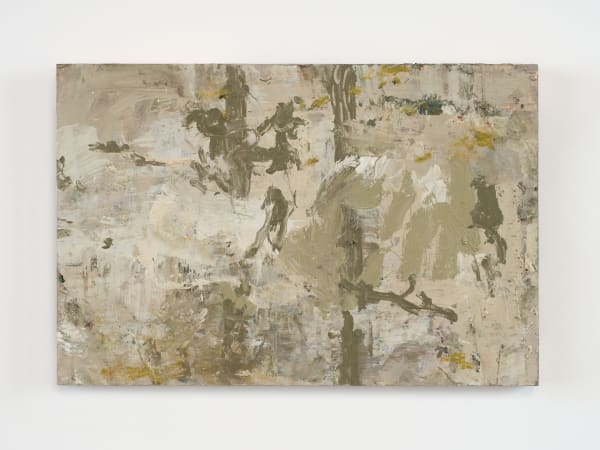Daniel Licht’s Irrational Element
by Marko Gluhaich
One moonlit night early in the season, after a light daytime snow melted and froze into a crust after dusk, that great poet of winter, Wallace Stevens, awoke to the sound of “a cat running over the snow under my window almost inaudibly.” He describes, in his essay “The Irrational Element in Poetry” (1957), “the faintness and strangeness of this sound” as a pretext for writing poetry—the suggestive nature of sensory experiences with ambiguous or uncertain referents. Poetry lingers in that space between sense and the thing.
Daniel Licht has told me his painting practice is like a dog digging a hole; I’d say it’s like listening to a cat walking over crusty snow. In his paintings, we see Stevens’s firecat leaping, his bucks clattering. Licht’s paintings demonstrate the -ing rhyme of “thing” and “being”—or of “thing” and any gerund, for that matter. His Lamb (2024) represents a frame of and acts as a Muybridge sequence. It may be just surface (as all things are, Nietzsche wrote at some point), but the wilderness (Stevens, again) rises up to it. We see the accidents of knife, pencil, glove, drip, screws, and cup, like the cracks in a Grecian urn that contribute to its beauty.
Licht also told me that this show was, at one point, going to have something to do with the composer Arnold Schoenberg. Stevens owned two records of Schoenberg’s music: one of Klavierstücke, no. 2 only, and Verklärte Nacht, performed by the Minneapolis Symphony. The latter work contains an inverted ninth chord, which at the time was considered by the Vienna Music Society as “non-existent,” and the composition was therefore rejected by the organization. The composer responded that the work therefore “cannot be performed since one cannot perform that which does not exist.” But like in that flash before Stevens recognized the snowy cat, this “non-existence” can engender so much, and has.
Take Canto (2024), whose working title had been My Sails in Rags, after a lyric in Gillian Welch’s song “I Dream a Highway” (2001). The almost-gradient, black-to-gray base is lit up by dabs of umber and gold and streaks of ashy white; the panel is scored by pencils, which both shape the paint and rupture its foundation. It may be a slab of marble from Versilia—the surface, tessellations of ancient sea beds; the cracks, mishaps from the quarry. But no, these latter marks betray intention, almost Cy Twombly–like in their resemblance to cursive but even more pre-linguistic—scribbles in search of meaning. The foreground arises from the bright strokes suggesting perhaps a sea monster, an oblong skull, or a boat as seen from above. Perhaps all—one thing leads to another.
Licht has written that his painting is interested in the gap between intention and realization. His paintings invite us to reflect on what directs that process: is it something like experience? Or is it more a tension between the thing-in-itself and the thing-at-hand (to steal some language from another Licht influence Martin Heidegger)? Or maybe how a thing exists and our perception of it? Maybe best to read Licht’s paintings via Stevens’s “The Man with the Blue Guitar” (1937): “Things as they are / are changed upon the blue guitar.” Such transformations happen in each of his paintings and they’re thrillingly beautiful. What else could that cat walking outside Stevens’s window have been? How can Licht’s paintings—resting in that terrifying space between the sensory and the real—invite the irrational element into how we relate to our surroundings?
The exhibition is on view from June 7 to July 13, 2024, Tuesday through Saturday, from 11:00 AM to 6:00 PM
For additional information, please contact info@vardangallery.com





















